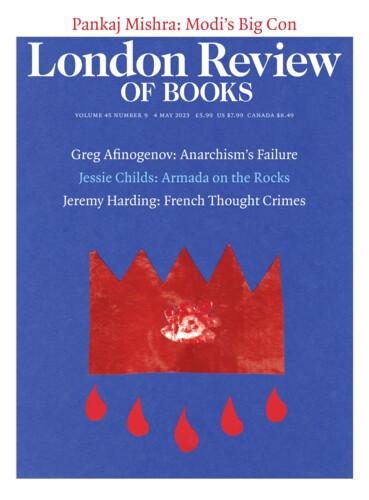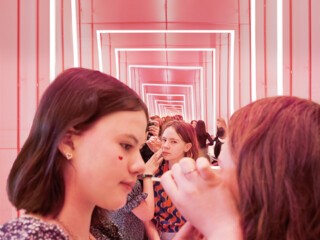Women looking at women. Girls looking at girls, looking at girls looking at girls. Women and girls alone, in pairs, threes, fours. Women and girls looking at themselves, which is a version of looking at each other but also something different. Women and girls looking back – looking towards, away, in profile, two-thirds and three-quarter views. One could fall in love with looking at the women looking in Hannah Starkey’s vivid, large-scale photographs, currently on display at the Hepworth Wakefield (until 1 May). It’s the details that quicken the pulse. The way her hair falls; the way she cocks her hip to the side; the roll of her trouser cuff; fingers softly interlaced; the faint wrinkle of her dress; her pencil-thin eyebrows; the way the tendons in her forearm stretch the skin as she plays with her lighter; the fact that she is oblivious to us.
Starkey, who has been photographing women for 25 years, has said that she is interested in psychological rather than photographic truth (a fiction in any case). Her works combine elements of street photography, theatrical mises-en-scène and traditional portraiture. Often she encounters her subjects in daily life and then invites them to collaborate; the environment in which the actual photograph is made is highly controlled. Starkey might be struck by a gesture or a glance, an interaction, a fortuitous interplay of colour, light, texture – ‘something that triggers a visual representation’. She then proceeds to craft a narrative: ‘I take the magnetic element of whatever made me want to look in the first place and then reconstruct that.’
In Kirkgate Towers, 2022, it is a wisp of hair – ‘one strand of hair that is not dark moves over to the dark side,’ as Starkey puts it. One of a series of works made with young women in Wakefield, the photograph shows a teenage girl from behind as she looks out over 1960s housing blocks edged in yellow and green. She wears blue jeans and a light blue sweater, which has lifted up above her midriff; the sun must be behind her (behind us) because the towers appear brightly lit against an ominous sky. The girl’s hair – half dark brown, half platinum blonde, divided neatly down the middle – echoes the light and shade of the buildings, the stripes of darker and lighter brick. The wisp of blonde hair lies against the dark hair like a single, painterly stroke. There is contingency even in Starkey’s carefully marshalled settings. The breeze that lifted the girl’s hair here provided that ‘lightness of touch which I can’t predict’.
The details that snag and fix the viewer’s gaze across the 47 works on display at the Hepworth won’t necessarily be those that caught Starkey’s attention. In Untitled, August 1999, it might be the contrast between the huge, cartoonish religious mural and the four girls standing beneath it. It might be the girl in the foreground with her head turned, looking back saucily, dressed for a fancy occasion in a fitted crimson skirt and black boa jacket. Or it might be her friend, in a pale blue dress with matching blue-striped shoes, arms and legs crossed, ruddy with cold. Girls looking at girls, desperate to be women looking at women: it never happens quickly enough. It might be the lists of names written in white on the wall: LISA, CIARA, DANIELLE, LINSDAY, V.I.P. In Untitled, March 2022, it could be the mise en abyme of pale pinks and halogen squares cascading into the distance, a Droste frame for two adolescent girls applying make-up (a tiny red heart on the right cheek) to each other in a bathroom. Or, between the jigsaw puzzle of faces, the woman’s hand holding a camera. Or something else, something I didn’t notice at all.
In describing Starkey’s work, critics have sometimes resorted to words such as ‘banal’ and ‘quotidian’, ‘everyday’ and ‘alienated’ and ‘lonely’. Better words would be ‘exquisite’ and ‘spectacular’ and ‘enigmatic’ and ‘autonomous’. If only the everyday were so richly textured, bright, precious and considered. Starkey’s photographs suggest that, given time and the right conditions, transformative details might bring forth meaning we didn’t know was there.
She is also attentive to her medium. Reflective surfaces appear in many of her images, doorways and windows act as frames within frames, perspectives are multiplied or collapsed. The technology of the lens, so often conflated with the eye and the photographer’s act of looking, is reproduced by the intersecting gazes of the women who also look, not just in mirrors and windows and at other women, but beyond the frame of the image, beyond our seeing. Paris Mirrors, September 2016 shows a street vendor’s stall bearing dozens of round vanity mirrors. Each has a sticker describing its magnification: x3, x7, x10. At the centre of the image, one mirror reflects a dark-haired woman in profile. She appears again in the mirror behind, but flipped upside down; now we can see she is walking with an older companion, a woman with glasses and grey hair. Other mirrors offer us shards of the scene – the street, a doorway, a building rising up against the sky – but they are too disparate to cohere. Instead, they are linked by the blue that echoes from the woman’s jacket to her friend’s scarf to the brilliant sky.
Untitled, March 1999 shows two women in a public bathroom, framed and multiplied by one large rectangular mirror fixed to a wall and four free-standing square mirrors hung above four pale pink sinks. Further rectangles and squares guide the eye: a row of bathroom stalls with doors ajar, shiny square wall tiles, soap dispensers, wall vents, an out-of-order sanitary towel dispenser, a hand-dryer. The women are seen only in reflection, save for the forearm and hand of one of the figures, who leans on a counter and flicks her lighter, her eyes fixed on the small flame. We might detect a nod to Manet’s Bar at the Folies-Bergère and to Jeff Wall’s Cibachrome lightbox homage to Manet, Picture for Women, in which the bar is replaced by an artist’s studio, with the customer in the mirror now a photographer who holds the shutter release cable. Starkey is conscious of her antecedents and her combination of the staged and the documentary puts her in company with Bill Brandt, Philip-Lorca diCorcia, Gregory Crewdson, Wall and others. It’s more interesting, however, to consider her work alongside that of contemporary female practitioners: the psychoanalytically inflected images of young girls by Sarah Jones; Justine Kurland’s wayward ‘Girl Pictures’; Deana Lawson’s richly detailed portraits.
At the Hepworth, some of the photographs are accompanied by a short text describing their genesis, making explicit what is hinted at in their depiction of aspects of British social and political life over the last few decades (a demolished linen mill, marches for women’s rights and Black Lives Matter, climate crisis protests, Extinction Rebellion camps). Other images are less prescriptive. ‘I try to keep my images quite wide and ambiguous,’ Starkey has said. ‘I tend not to tell stories about what the images are about or why they are like this because if you have to ask, then it has failed.’ The story is in the composition of figures, the subtle framing (Starkey’s images are always landscape format), repeating patterns and shapes and sumptuous colour. Untitled, August 1999 is an image of four women (one of them Starkey’s mother) outside a community centre in Belfast. The indigo night sky and the building’s green hues contrast with the flood of gold fluorescent light under which the women stand. It’s almost Technicolor, a Douglas Sirk still, a portal into a world more gorgeous than our own.
Send Letters To:
The Editor
London Review of Books,
28 Little Russell Street
London, WC1A 2HN
letters@lrb.co.uk
Please include name, address, and a telephone number.


